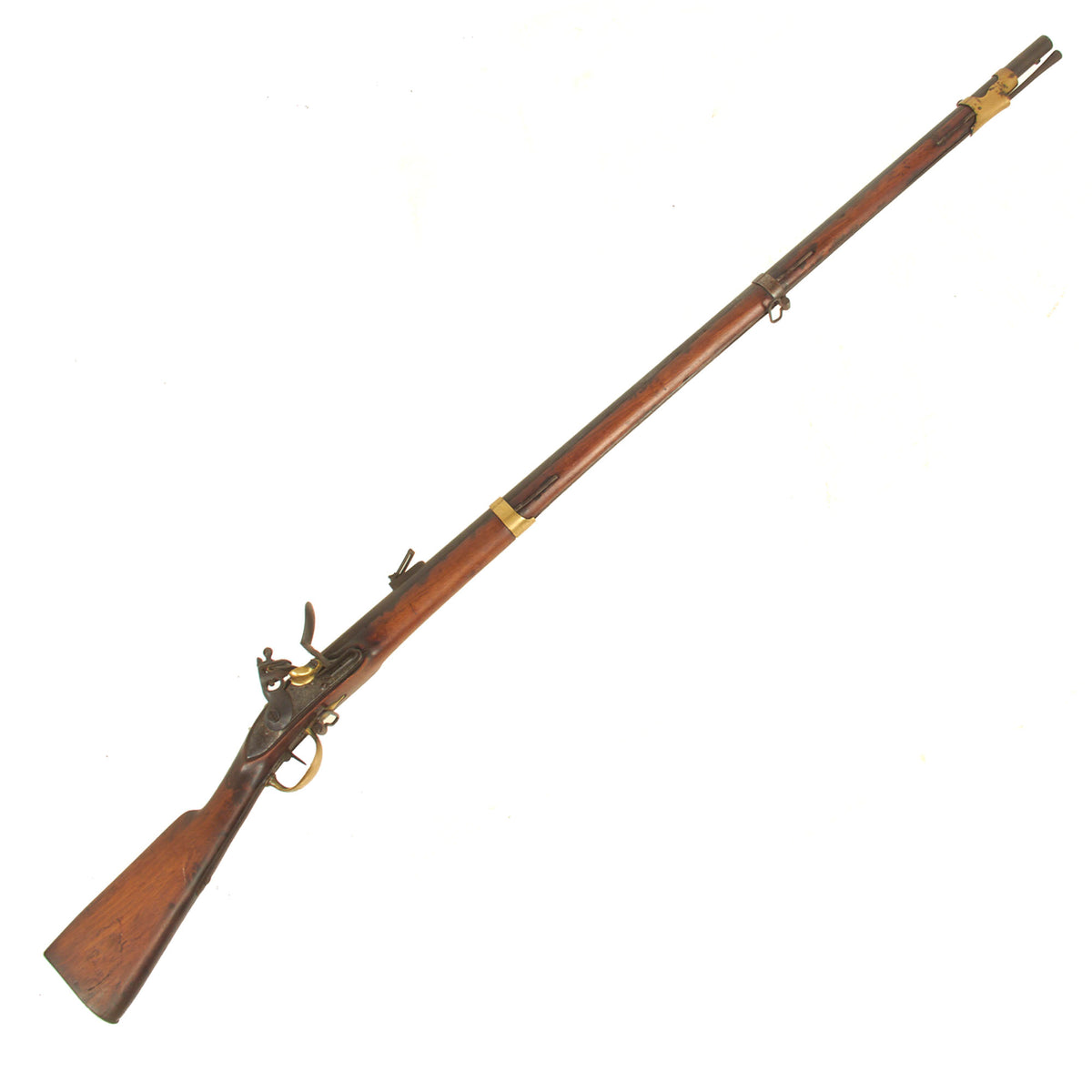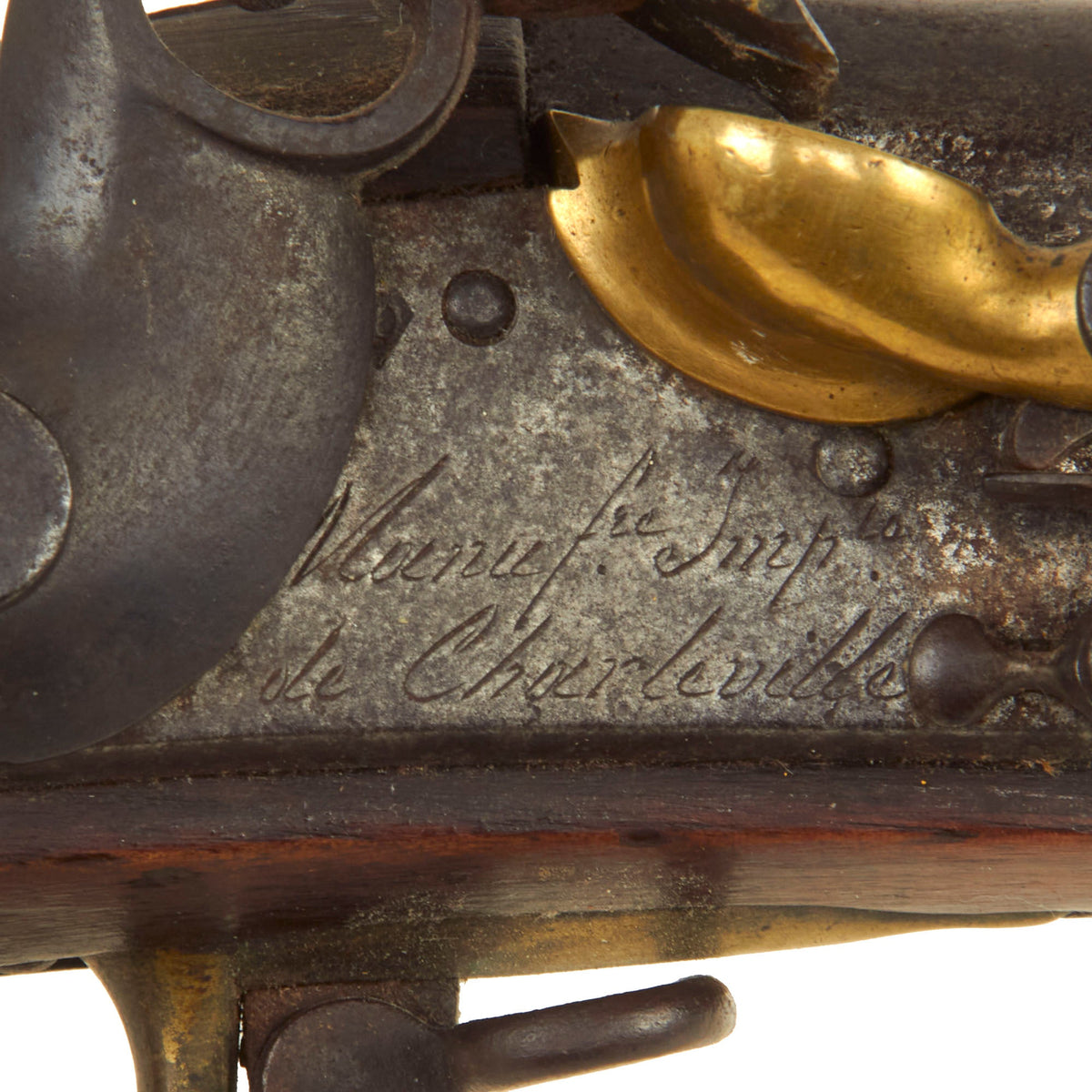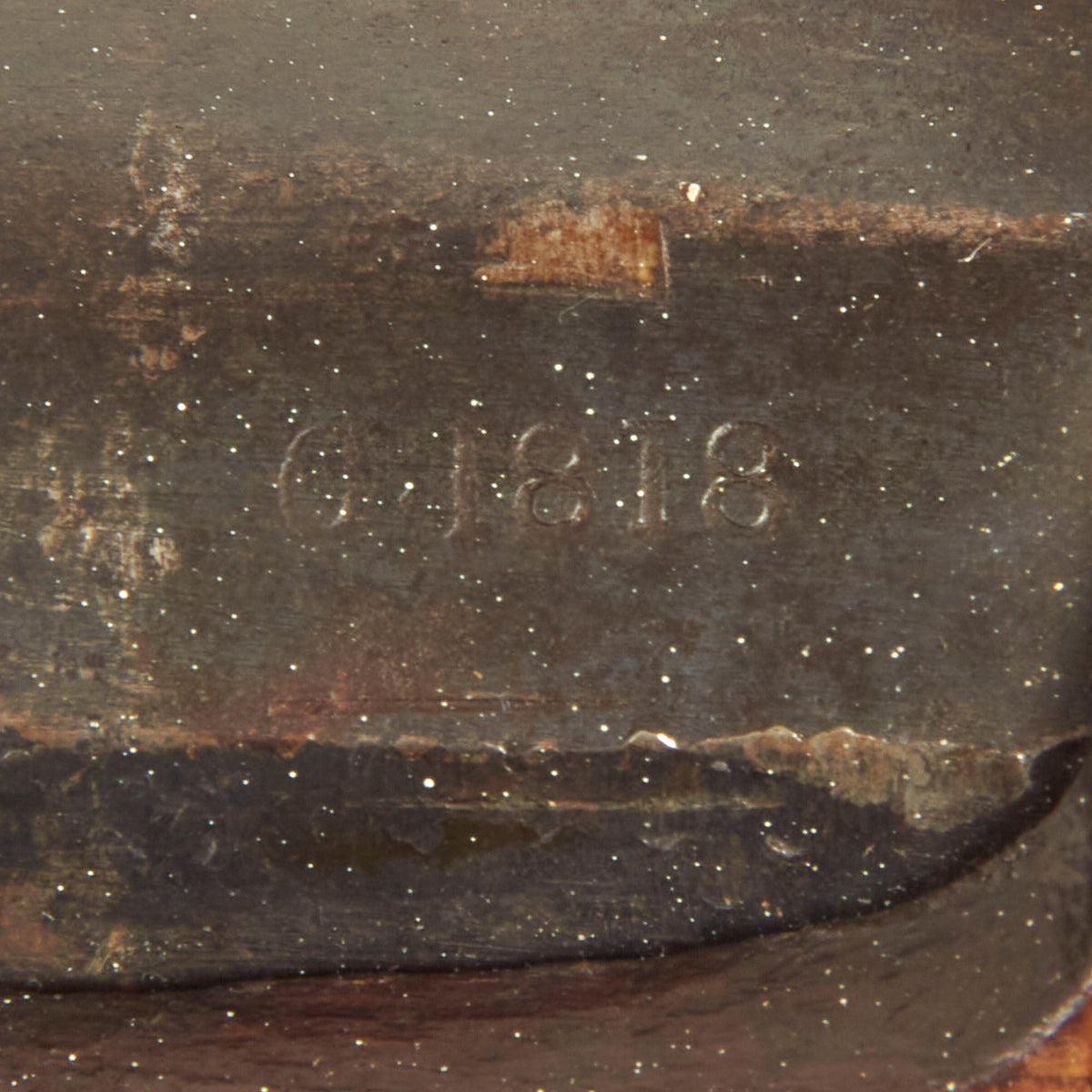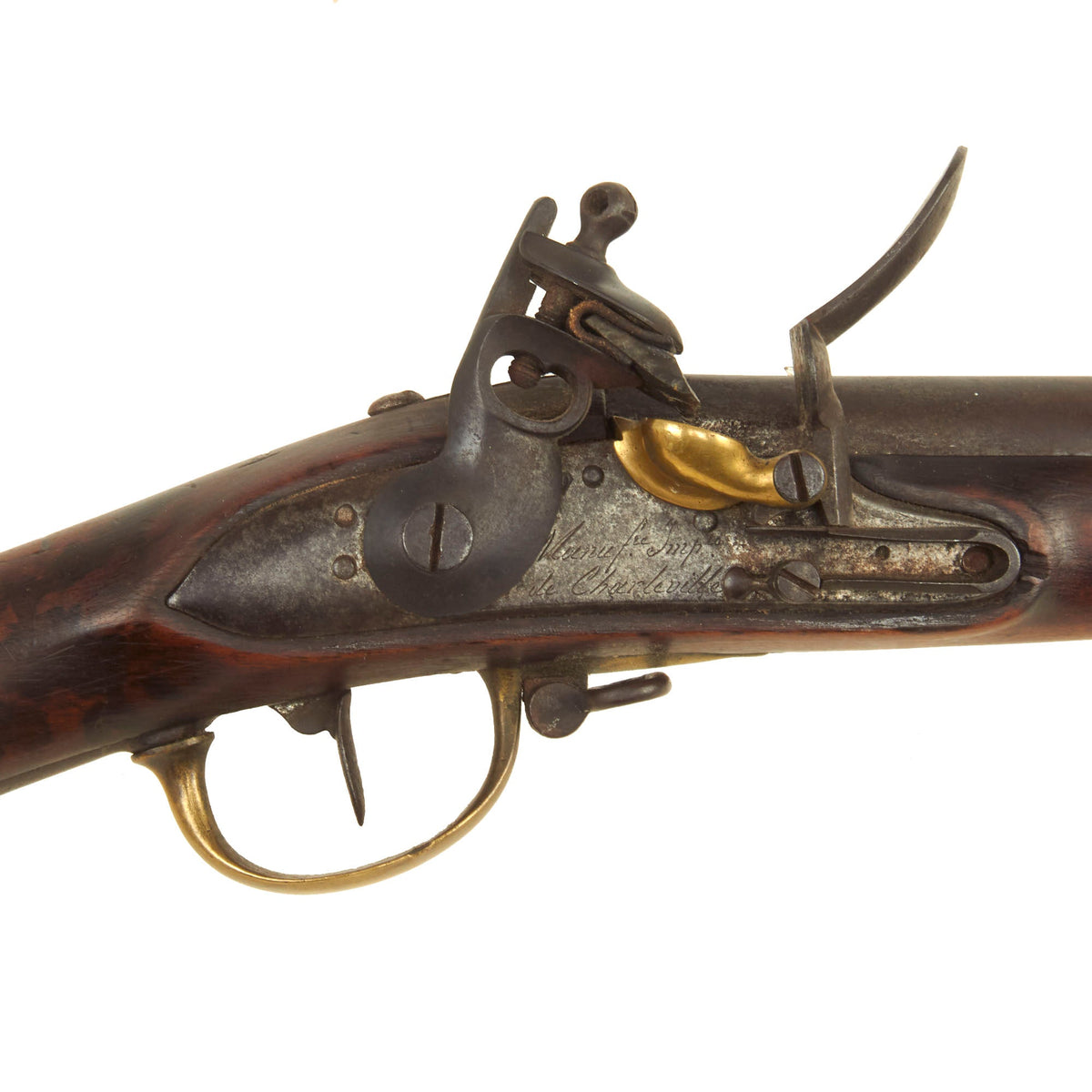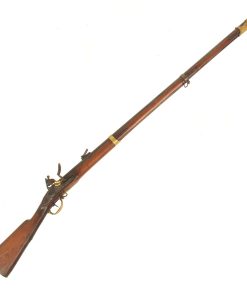Original French Napoleonic Modèle 1777 Corrigé Flintlock Musket by Charleville Arsenal – Barrel dated 1818 Original Items
$ 1.895,00 $ 473,75
Original Item: Only One Available. The “Charleville” line of flintlock muskets is the French equivalent of the venerable “Brown Bess” used by the British. First introduced in 1717, the design was updated numerous times until production finally ceased in the early 1840s, when it was superseded by the “back action” Modèle 1842 percussion musket. The M1763 and M1876 versions were supplied in some quantities to the American Colonies during the Revolutionary War.
However, the most well-known variants worldwide are probably the Modèle 1777 and later Modèle 1777 corrigé en l’an IX (Model 1777 corrected in the year IX, or 1800 in the French Revolutionary Calendar), which were the primary muskets of the line during the French Napoleonic Wars. Compared to the earlier Modèle 1763, these introduced a cheek rest on the left hand side of the butt stock, and also featured a slanted brass priming pan and bridle. The trigger guard was modified with two rear finger ridges, a design also seen in the later M1842 muskets.
Following the end of the Napoleonic Wars, the M1777 was further modified to the Modèle 1816, which changed the angled brass flash pan to a flat one with a rear “fence” to stop powder remnants and other debris from flying into the eyes of the solder. The shape of the flashhole was changed to be conical as well. Six years later, the Modèle 1822 was introduced, which mainly involved changes to the lock, with many more components being made from steel instead of iron, to increase longevity. All told, 7 million of all variants of the M1777 were made, making it the largest produced firearm until World War I came around.
This is a very interesting example of the Modèle 1777 corrigé en l’an IX, which looks to have seen long service, possibly having parts replaced over time. The mountings are brass for the most part, except for the middle barrel band and the base of the brass trigger guard, which usually indicates Naval Issue. It has the correct slanted brass flash pan for the Model, but the stock does not have a cheek rest on the left side, and there are no ribs on the tang of the trigger guard. It also has some type of ladder rear sight that was added to the barrel, most likely decades after manufacture. The barrel is dated C.1818, which we assume is an inspection marking, but it is possible that it is a manufacture marking. Definitely some fantastic research potential in this musket!
Many of these were later converted to percussion and often shortened as well, but this musket is still in the original flintlock configuration, and has the correct overall length of 60 inches. The lock is marked faintly with Manuf’re Imp’le / de Charleville, the abbreviation for Manufacture Impériale de Charleville used during the Napoleonic Era. This indicates production at the famed IMPERIAL ARSENAL at CHARLEVILLE. This Arms Manufacturing installation was located in Charleville-Mézières, Ardennes, France, to the far north east of Paris, and was responsible for developing the famous “Charleville” muskets of the line and many other firearms. It was later closed, as it was realized that having an arsenal that close to the eastern border of France was not strategically viable, especially after the Prussian army plundered it in 1815. Differing from the Brown Bess not only using all steel mounts the barrel is secured by three-barrel bands, and not pins.
Condition is very good, with the original bright steel finish of the metalwork now faded to a dark oxidized patina that is simply lovely. There are some faint arsenal markings on various components of the musket, and the initials LMB have been carved to the rear of the barrel tang on the wrist. The lock is functional, but has a worn tumbler, so it will fire at both the full and half cock positions. The cock is in great shape, fully adjustable, and has been fitted with a flint and lead pad to complete the look. Both sling swivels are present, as is the original ramrod under the barrel.
The stock is in very good condition, showing the expected dents and other light damage from service. There also is some staining in areas from the iron and steel components oxidizing. There is a bit of woodworm damage on the right side of the butt stock, but this does not appear to have caused any structural damage.
This is a very interesting example of the legendary “Charleville” line of muskets, ready to research and display!
Year of Manufacture: circa 1810
Caliber: .69″
Cartridge Type: Ball and Powder
Barrel Length: 45 Inches
Overall Length: 60 Inches
Action type: Side Action Flintlock
Feed System: Muzzle Loaded
NOTE: International orders of antique firearms MUST be shipped using UPS WW Services (courier). USPS Priority Mail international will not accept these. International customers should always consult their country’s antique gun laws prior to ordering.
Fast Shipping with Professional Packaging
Thanks to our longstanding association with UPS FedEx DHL, and other major international carriers, we are able to provide a range of shipping options. Our warehouse staff is expertly trained and will wrap your products according to our exact and precise specifications. Prior to shipping, your goods will be thoroughly examined and securely secured. We ship to thousands clients each day across multiple countries. This shows how we're dedicated to be the largest retailer on the internet. Warehouses and distribution centres can be located throughout Europe as well as the USA.
Note: Orders with more than one item will be assigned a processing date depending on the item.
Before shipping before shipping, we'll conduct a thorough inspection of the items you have ordered. Today, the majority of orders will be delivered within 48 hours. The delivery time will be between 3-7 days.
Returns
The stock is dynamic and we cannot completely manage it because multiple stakeholders are involved, including our factory and warehouse. So the actual stock may alter at any time. It's possible that you may not receive your order once the order has been made.
Our policy is valid for a period of 30 days. If you don't receive the product within 30 days, we are not able to issue a refund or an exchange.
You can only return an item if it is unused and in the same state as the day you received it. You must have the item in its original packaging.
Related products
Uncategorized
Uncategorized
Uncategorized
Uncategorized
Uncategorized
Uncategorized
Uncategorized
Uncategorized
Uncategorized
Uncategorized
Armoured Fighting Vehicles of the World: AFVs of World War One (Hardcover Book) New Made Items
Uncategorized
Uncategorized
Uncategorized
Uncategorized
Uncategorized
Uncategorized
Band of Brothers ORIGINAL GERMAN WWII Le. F.H. 18 10.5cm ARTILLERY PIECE Original Items
Uncategorized
Uncategorized
Uncategorized
Uncategorized
Armored Burgonet Helmet & Polearm from Scottish Castle Leith Hall Circa 1700 Original Items
